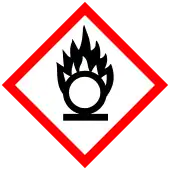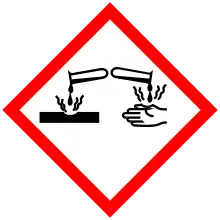Tin(IV) nitrate
Tin(IV) nitrate is a salt of tin with nitric acid. Unlike other nitrates it reacts with water to produce nitrogen dioxide.
| Names | |
|---|---|
Other names
| |
| Identifiers | |
3D model (JSmol) |
|
| ChemSpider | |
| ECHA InfoCard | 100.222.600 |
| EC Number |
|
PubChem CID |
|
| |
| |
| Properties | |
| Molar mass | 366.73 g/mol |
| Appearance | Silky Crystals |
| Reacts | |
| Solubility | Soluble in carbon tetrachloride |
| Hazards | |
| GHS labelling: | |
  | |
| Danger | |
| H272, H314 | |
| P220, P280, P305+P351+P338, P310 | |
Except where otherwise noted, data are given for materials in their standard state (at 25 °C [77 °F], 100 kPa).
Infobox references | |
Production
It was first prepared in the 1960s. Tin(IV) chloride was added to melted dinitrogen pentoxide which created tin(IV) nitrate and nitryl chloride.[3]
Attempts to prepare this compound by reacting tin(II) oxide and nitric acid resulted in a formation of tin(II) nitrate hydroxide.[4]
Reactions
Tin(IV) nitrate reacts with trifloroacetic acid anhydride to yield (NO2+)2[Sn(OOCCF3)62−] which is a nitronium salt. With trifluoroacetic acid a similar compound solvated with trifluoroacetic acid is produced.[5]
It also reacts with acetic anhydride to produce tin(IV) acetate and with nitric oxide to produce tin(IV) oxynitrate.
References
- "Tin(IV) Nitrate". American Elements. American Elements. Retrieved 16 February 2021.
- "Tin(IV) nitrate". Sigma-Aldrich. Sigma-Aldrich. Retrieved 16 February 2021.
- Chemical Society (Great Britain) (1965). Journal of the Chemical Society. The Society. p. 598.
Titles of chemical papers in British and foreign journals" included in Quarterly journal
- J. D. Donaldson; W. Moser (1961). "Basic tin(II) nitrate". Journal of the Chemical Society (Resumed). 381: 1996–2000. doi:10.1039/JR9610001996.
- Harrison, Philip G.; Khalil, Mutassim I.; Logan, Norman (January 1978). "A contribution to the chemistry of tin(IV) nitrate". Inorganica Chimica Acta. 30: 165–170. doi:10.1016/S0020-1693(00)89031-3.
| HNO3 | He | ||||||||||||||||
| LiNO3 | Be(NO3)2 | B(NO 3)− 4 |
RONO2 | NO− 3 NH4NO3 |
HOONO2 | FNO3 | Ne | ||||||||||
| NaNO3 | Mg(NO3)2 | Al(NO3)3 | Si | P | S | ClONO2 | Ar | ||||||||||
| KNO3 | Ca(NO3)2 | Sc(NO3)3 | Ti(NO3)4 | VO(NO3)3 | Cr(NO3)3 | Mn(NO3)2 | Fe(NO3)2 Fe(NO3)3 |
Co(NO3)2 Co(NO3)3 |
Ni(NO3)2 | CuNO3 Cu(NO3)2 |
Zn(NO3)2 | Ga(NO3)3 | Ge | As | Se | BrNO3 | Kr |
| RbNO3 | Sr(NO3)2 | Y(NO3)3 | Zr(NO3)4 | Nb | Mo | Tc | Ru(NO3)3 | Rh(NO3)3 | Pd(NO3)2 Pd(NO3)4 |
AgNO3 Ag(NO3)2 |
Cd(NO3)2 | In(NO3)3 | Sn(NO3)4 | Sb(NO3)3 | Te | INO3 | Xe(NO3)2 |
| CsNO3 | Ba(NO3)2 | Hf(NO3)4 | Ta | W | Re | Os | Ir | Pt(NO3)2 Pt(NO3)4 |
Au(NO3)3 | Hg2(NO3)2 Hg(NO3)2 |
TlNO3 Tl(NO3)3 |
Pb(NO3)2 | Bi(NO3)3 BiO(NO3) |
Po(NO3)4 | At | Rn | |
| FrNO3 | Ra(NO3)2 | Rf | Db | Sg | Bh | Hs | Mt | Ds | Rg | Cn | Nh | Fl | Mc | Lv | Ts | Og | |
| ↓ | |||||||||||||||||
| La(NO3)3 | Ce(NO3)3 Ce(NO3)4 |
Pr(NO3)3 | Nd(NO3)3 | Pm(NO3)3 | Sm(NO3)3 | Eu(NO3)3 | Gd(NO3)3 | Tb(NO3)3 | Dy(NO3)3 | Ho(NO3)3 | Er(NO3)3 | Tm(NO3)3 | Yb(NO3)3 | Lu(NO3)3 | |||
| Ac(NO3)3 | Th(NO3)4 | PaO2(NO3)3 | UO2(NO3)2 | Np(NO3)4 | Pu(NO3)4 | Am(NO3)3 | Cm(NO3)3 | Bk(NO3)3 | Cf | Es | Fm | Md | No | Lr | |||
This article is issued from Wikipedia. The text is licensed under Creative Commons - Attribution - Sharealike. Additional terms may apply for the media files.